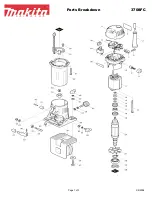
6
3. Pull starter rope sharply until engine runs,
but no more than 5 pulls.
4. Allow engine to run 15 seconds, then move
the choke lever to OFF CHOKE.
NOTE:
If engine has not started, pull starter
rope 5 more pulls. If engine still does not run, it
is probably flooded.
STARTING A FLOODED ENGINE
Flooded engines can be started by placing
the choke lever in the OFF CHOKE position;
then, pull the rope to clear the engine of ex-
cess fuel. This could require pulling the starter
handle many times depending on how badly
the unit is flooded.
If the unit still doesn’t start, refer to
TROUBLESHOOTING
TABLE
or
call
1-800-554-6723.
OPERATING INSTRUCTIONS
OPERATING POSITION
Eye Protection
Long Pants
Heavy Shoes
ALWAYS WEAR:
STYLE A
Eye Protection
Long Pants
Heavy Shoes
ALWAYS WEAR:
STYLE B
Cut from your right to your left.
WARNING:
Always wear eye protec-
tion. Never lean over the trimmer head.
Rocks or debris can ricochet or be thrown into
eyes and face and cause blindness or other
serious injury.
Do not run the engine at a higher speed than
necessary. The cutting line will cut efficiently
when the engine is run at less than full throttle.
At lower speeds, there is less engine noise and
vibration. The cutting line will last longer and will
be less likely to “weld” onto the spool.
Always release the throttle trigger and allow the
engine to return to idle speed when not cutting.
To stop engine:
S
Release the throttle trigger.
S
Push and release the engine ON/STOP
switch.
TRIMMER LINE ADVANCE
The trimmer line will advance approximately 2
in. (5 cm) each time the bottom of the trimmer
head is tapped on the ground with the engine
running at full throttle.
The most efficient line length is the maximum
length allowed by the line limiter.Always keep
the shield in place when the tool is being oper-
ated.
To advance line:
S
Operate the engine at full throttle.
S
Hold the trimmer head parallel to and above
the grassy area.
S
Tap the bottom of the trimmer head lightly
on the ground one time. Approximately 2 in.
(5 cm) of line will be advanced with each
tap.
Always tap the trimmer head on a grassy
area. Tapping on surfaces such as concrete
or asphalt can cause excessive wear to the
trimmer head.
If the line is worn down to 2 inches (5 cm) or
less, more than one tap will be required to ob-
tain the most efficient line length.
WARNING:
Use only 0.065” (1.65
mm) diameter line. Other sizes and shapes of
line will not advance properly and will result in
improper cutting head function or can cause
serious injury. Do not use other materials
such as wire, string, rope, etc. Wire can break
off during cutting and become a dangerous
missile that can cause serious injury.
CUTTING METHODS
WARNING:
Use minimum speed
and do not crowd the line when cutting around
hard objects (rock, gravel, fence posts, etc.),
which can damage the trimmer head, become
entangled in the line, or be thrown causing a
serious hazard.
S
The tip of the line does the cutting. You will
achieve the best performance and mini-
mum line wear by not crowding the line into
the cutting area. The right and wrong ways
are shown below.
Tip of the Line
Does The Cutting
Right
Wrong
Line Crowded Into
Work Area
S
The line will easily remove grass and
weeds from around walls, fences, trees and
flower beds, but it also can cut the tender
bark of trees or shrubs and scar fences. To
help avoid damage especially to delicate
vegetation or trees with tender bark,
shorten line to 4--5 in. (10--13 cm) and use
at less than full throttle.
S
For trimming or scalping, use less than full
throttle to increase line life and decrease
head wear, especially:
S
During light duty cutting.





























